Winterail, the annual memorabelia and multi-media photography event held in Stockton until 2016, was an event that I had known about for many years. I had only attended one previously, in 2010, mainly because there were two competing railroadiana shows that usually fell on the same day. The other one was Western Rails, held at the Cameron Recreation Centre in Burnaby, British Columbia. For several years, I attended this show and always included some railfanning and visits to area railyards. But the opportunity to visit the Niles Canyon Railway for their post-Winterail Photographers Special as well as attend another Winterail and join Chris Guenzler and Chris Parker on a journey up the valley on the way to Stockton was much more appealing this year.
So Bob and I flew down to Los Angeles on March 7th, rode the Flyaway bus to Los Angeles Union Passenger Terminal and soon were on the road. Our first stop was the Grill Hut in Bakersfield, which was fittingly housed in a former Santa Fe passenger car.
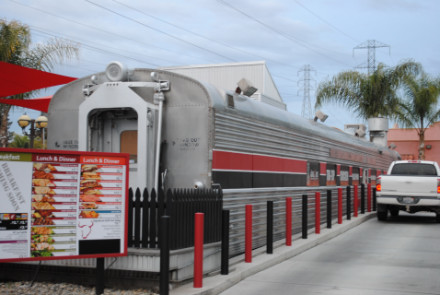
The Grill Hut Restaurant, which unfortunately no longer exists. After dinner, we drove through some rain showers on the way to Wasco where we watched Amtrak Capital Corridor 703 arrive before we made our way to Hanford for the night.
The next morning, we stopped by the Hanford Santa Fe station, built in 1897.
A westbound BNSF freight train in the early morning rain.
Train arrival and departure boards. Then Chris took us to see the two remaining wig-wag signals in the city.
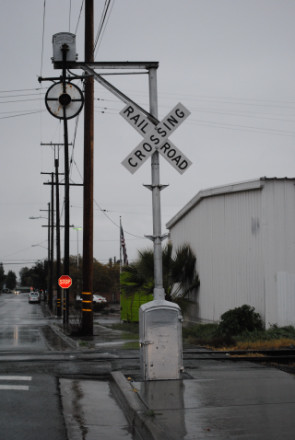
The Redinginton Street wig-wag signal on the San Joaquin Valley Line.
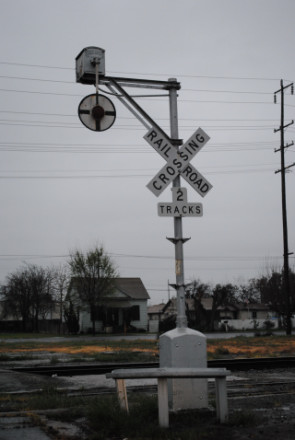
The Brown Street wig-wag signal. From here we made our way to Lemoore.
The 1912 Southern Pacific station from Strathmore that was moved to Lemoore and restored.
The plaque on the side of the station.
A mailbox in the shape of a caboose outside the station.
The tenatns of the Lemoore depot. We continued on to Visalia.
The former Southern Pacific station built in 1916 which is home to the Southern Pacific Depot Restaurant. In autumn 1852, a small group of settlers arrived about a block from its location and established a log fort, later known as Fort Visalia. One settler, Nathaniel Vise, claimed much of the land that is now downtown Visalia. He never finalized the acquisition, but because of his early holdings, the settlement took on the name of Visalia. That was a reflection of the town of Visalia, Kentucky, named for his family. Tulare County was formed in 1852 and in 1853, voters chose Visalia as the county seat. Thus, unlike many towns in California's San Joaquin Valley, Visalia was not founded by the railroad. Yet early Visalians desired a railroad to transport passengers and commerce. Serious efforts began in the 1860's. A decade later, Visalia had an ideal opportunity: The Central Pacific Railroad was building south from Lathrop, and the Southern Pacific Railroad was building north from Bakersfield.
Yet Visalia was bypassed when the railroads chose in 1872 to build Goshen, to the west. Visalia business owners were disappointed so in 1874, they created the Visalia Railroad Co. to build a spur line between Goshen and Visalia. The line was completed by 1875 and the first railroad depot opened at Jacob Street and Goshen Avenue, near what is now Recreation Park. At the time, that was far west of town. Passengers had to rent buggies to meet the train. In 1893, a new depot was built at the restaurant's location, the southeast corner of Oak Avenue and Church Street. Then in 1897 the Southern Pacific Railroad purchased the Visalia-Goshen line. But there were problems: the depot was inadequate for the volume of freight and passenger traffic. In 1906-1907, passengers complained about having to wade through deep mud to get inside. Talk of a new depot began in 1910. By 1915, work began on our building. (The 1893 depot was moved one block east to serve as a freight depot. The building remained there until 1982, when a fire resulted in its demolition.)
Our next stop was the 1914 Southern Pacific station in Orange Cove, now City Hall and visit inside netted a municipal lapel pin for my collection. Then it was on to Reedley and the most interesting Hillcrest and Wahtoke Railroad and the Hillcrest Tree Farm. Chris had organized for a tour of the property which Melissa Bautista gave us, starting with the shop.
A steam boiler being worked on.
Wheel set.
Looking out to part of the grounds.
Folsom Valley Railway tender.
"Cricket" steam engine under restoration here.
Machinery in the engine shop.
Glenwood, South Park and Pacific 2-6-0 5, on long-term loan, in the long and narrow locomotive storage area.
Glenwood, South Park and Pacific 2-8-0 13, on long-term loan. This was built in a one-car garage by West-Side Locomotive Works aka Ken Kukuk in Culver City, California, and the tender by Jim "Homer" Holms in San Jose, for the Glenwood, South Park & Pacific Railroad located in the mountains above Santa Cruz. It is patterened after South Coast Railroad 13.
The cab of Glenwood, South Park and Pacific 13.
A logging skidder.
Hillcrest and Wahtoke Railroad ballast car 103.
A bridge on the future line that the railway plans to build.
Future tunnel location.
Bridge on the in-service part of the railway.
The view as we walked from the shop area to the car barn.
The series of switches in front of the car barn.
A view inside the car barn and the gondola cars in which people ride.
The switches in front of the car barn, from the other side.
A single spiker. Our tour continued and became even more interesting.
Passenger car from the Fort Wilderness Railway (Disneyworld) awaiting restoration.
Steam engine and passenger car from the Fort Wilderness Railway. We had had an excellent tour but train rides were only offered on the weekends for the first three weekends in March. Since this was a Friday, no train. However, Chris Guenzler and Chris Parker returned here on Sunday but Bob and I flew home that afternoon. We left Reedley and drove to Sanger.
The 1888 Southern Pacific station in Sanger which is now a museum.
The Sanger station sign noting the miles to San Francisco and New Orleans.
At Fairbanks Avenue was a surprise - San Joaquin Valley GP40 3822 (ex Puget Sound and Pacific 3822, exx. Central Oregon and Pacific 3822, exxx. CORP 5042, exxxx. CSX 2042, exxxxx. Baltimore and Ohio 2042, nee B&O 3842) with former Esquimalt and Nanaimo GP38 3870 (ex. ENR 344, exx. Cascade and Columbia 344, exxx. Conrail Leasing 344, exxxx. PLE 2040, exxxxx. Conrail 7818 nee Penn Central 7818) and CEFX 3029.
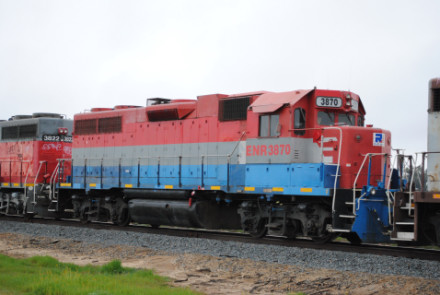
The last time I had seen that locomotive was in Nanaimo, British Columbia in 2002.
CEFX 3029 GP38-2 (nee Denver and Rio Grande 3029) as the third unit. Our journey north then took us to Lone Star.
The former Santa Fe station, built in 1913, with Santa Fe caboose 999362 on display in Lone Star.
Santa Fe caboose 999362 (nee ATSF 1976).
Rear views of the Santa Fe station. The next stop was in Clovis.
The 1892 Southern Pacific station in Tarpey which is now the tourist information and visitor's centre. It was restored in 1999.
The roof and tower.
The station sign.
The Tarpey Depot restoration plaque.
Two views of the Tarpey Depot history stone.
This most appealing station also had bay windows. We stopped in Madera for lunch at Carl's Jr the continued north to Le Grand.
The former Santa Fe station in Le Grand, in the midst of restoration.
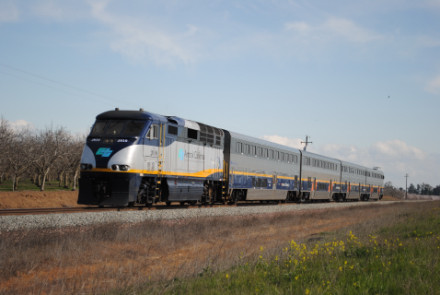
A train horn was heard and San Joaquin 714 en route to Bakersfield came through. Planada was our next destination.
BNSF 7008 East at the large curve here where an orchard had recently been planted.
We caught this BNSF train at Merced then drove through Hughson.
BNSF 7523 East at Hughson with a Kansas City Southern locomotive in second position. Then it was on to Modesto for my first views of the famed Modesto and Empire Traction, albeit with their modern power.
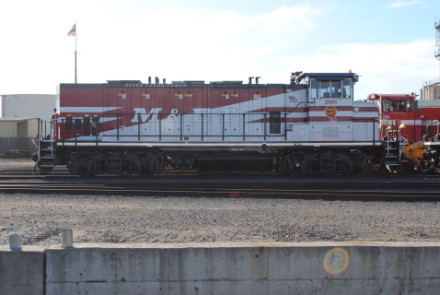
Modesto and Empire Traction RP20BD 2001 which was one of the original five Green Goat demonstrators. It was built from MidSouth 1043 2003, ex. IC GP10 8322 1971, exx. IC 9322, nee ICG GP9 9322.
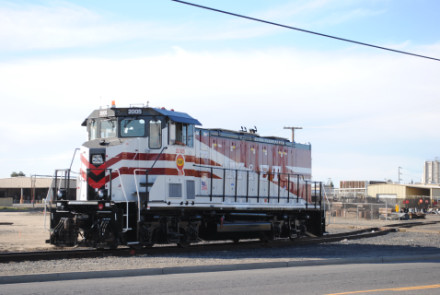
Modesto and Empire Traction RP20BD 2005. It was after this that Chris learned the sad news that his sister Laura had passed away. It had been expected but made the day and the rest of the trip somber. The last part of the drive to Stockton was made but a stop before we arrived at the Winterail venue.
The former Southern Pacific station in Stockton, built in 1900, and is the Altamont Commuter Express station, also used by Amtrak's San Joaquins.
The Robert J. Cabral banner on the pole outside the ACE station. Mr. Cabral was a former county supervisor who was a driving force behind the creation of ACE and the promotion of a reliable passenger rail network in northern California.
Part of the station platform with the Stockton sign. We drove the short distance to the Scottish Rite Masonic Temple for the Friday night pizza party and slide show which Railfan and Railroad Magazine has sponsored for several years. The shows were varied and excellent. Afterwards, we drove to the Red Roof Inn and checked in for the night.
WinterailFirst held in Sacramento in 1978, Winterail is the original railroad photography exposition and railroadiana show and sale. We pioneered the concept of multimedia slide presentations by the hobby's best photographers. The show quickly moved to its longtime home in Stockton (with a few detours to Modesto), and in 2016, we moved to our new home in beautiful Corvallis, Oregon. Produced by Vic and Annie Neves and our awesome team of roadies, every Winterail features an outstanding lineup of digital presentations from top rail photographers, plus a quality railroad collectibles.
March 9th
After a good breakfast at Perkos, Chris drove us to the site of the former Stockton Tower before going to Winterail. As usual, the railroadiana show opened at 09:00 and closed at 17:00 hrs so we had plenty of time to look around and acquire a few items before the shows started at noon. In the breaks, there was time to browse more or just stretch one's legs.
The two-and-a-half hour dinner break gave us time to go to dinner at Perkos. It was after dinner that Chris asked me to be his honourary sister. I was very touched by this and accepted this special tribute immediately, wholeheartedly taking the position. On the way back to Winterail, we stopped at Stockton crossing.
An eastbound BNSF stack train in the sunset. Upon returning to Winterail, the evening's shows were led off by the annual Hall of Fame presentation, which this year was given to Shirley Burman, widow of the late Richard Steinheimer. The fact that she was the first woman to win and the first husband-and-wife team to win was something to celebrate, but it paled in comparison to who she is and who her husband was. A long standing ovation was given and there were few dry eyes in the auditorium. She bravely presented "Sierra Journeys" which was excellent, then the remainder of the evening shows were presented and by 22:00 hrs, the 35th Winterail had come to an end. We all drove back to the hotel for the night.
| RETURN TO THE MAIN PAGE |